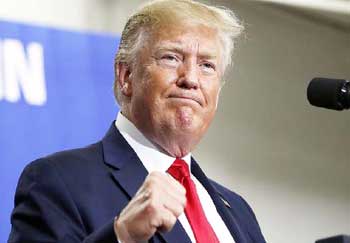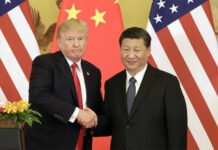The global economy has witnessed significant shifts in currency valuations as a direct consequence of the United States’ recent tariff policies. The Chinese yuan, Mexican peso, and Canadian dollar have experienced record drops, signaling the widespread impact of the tariffs introduced by President Donald Trump’s administration. This article examines the repercussions of these tariffs on the three currencies and how they have created an environment of growing trade tensions and uncertainty.
Understanding the US Tariff Policy and its Global Impact
The US administration’s tariff policies, which target imports from China, Canada, and Mexico, have escalated concerns about a potential global trade war. The tariffs, initially introduced as a measure to curb illegal immigration, deter the trafficking of dangerous chemicals such as fentanyl, and promote domestic manufacturing, have led to severe consequences for global financial markets. These tariffs, designed to discourage imports and encourage local production, are now affecting the value of the Chinese yuan, Mexican peso, and Canadian dollar.
Chinese Yuan Hits Record Lows Amid US Tariff Pressure
One of the most significant developments from the US tariff policies is the dramatic depreciation of the Chinese yuan. As of February 2025, the yuan has fallen to its lowest levels ever in offshore trading. This significant dip is the result of the US imposing 10% tariffs on Chinese imports, which has affected investor confidence in the currency. The Chinese government has struggled to counteract the depreciation as the country grapples with the mounting economic consequences of the trade restrictions.
Why the Yuan Is Falling
The devaluation of the yuan is primarily a result of the weakening trade relationships between the US and China. The tariffs have disrupted global supply chains, leading to an increase in production costs and an overall reduction in trade volume. Moreover, the Chinese government’s attempts to stabilize the yuan through interventions in the foreign exchange market have had limited success. The ongoing tariff-induced economic pressure, combined with domestic issues, has further compounded the situation.
This depreciation is also reflective of investor sentiment. As tariffs increase, businesses and traders often view the yuan as a weaker currency for trade and investment purposes. Consequently, the market’s reduced confidence in the yuan has led to its decline against other major global currencies.
Mexican Peso Faces Record Decline
Similar to the Chinese yuan, the Mexican peso has seen a significant drop in value in response to the tariffs imposed by the US. The peso reached historic lows, as the 25% tariff on imports from Mexico, including goods like agricultural products and vehicles, took effect. The Mexican economy, heavily dependent on exports to the US, is particularly vulnerable to such tariffs.
Factors Behind the Peso’s Plummet
The imposition of tariffs has not only diminished the appeal of the peso as a currency for global traders, but it has also contributed to inflationary pressures within Mexico. As US-based companies pass on the increased costs of imports to consumers, the Mexican economy faces the threat of rising prices, which could slow down growth.
Moreover, the political climate in Mexico has further exacerbated the situation. President Andres Manuel Lopez Obrador’s government has criticized the tariffs, with some suggesting that the tariffs are politically motivated, aimed at forcing Mexico to cooperate on issues like immigration and drug trafficking. This political uncertainty has played a role in the peso’s devaluation, making it a less attractive option for investors.
Canadian Dollar Faces Historic Weakness
The Canadian dollar (CAD) is another currency that has suffered as a result of the tariffs. Although Canada’s trade relations with the US are relatively strong, the 25% tariff on imports has negatively impacted the CAD, causing it to drop to levels not seen in years.
Why the Canadian Dollar Is Struggling
The decline of the Canadian dollar can be attributed to several factors. First, the tariff on goods like automobile exports and energy products is having a detrimental impact on Canada’s most significant industries. With the US as Canada’s largest trading partner, any slowdown in trade can have an outsized effect on the Canadian economy. This, in turn, weakens the CAD in international markets.
Additionally, the global perception of Canada’s economic stability is challenged by these tariffs. Investors and foreign institutions often look to the strength of Canada’s economy before making investment decisions. With these new tariffs creating friction in trade relationships, the Canadian dollar’s weakened state reflects the broader economic instability caused by the imposition of tariffs.
Global Economic Consequences of Trade Wars
The trade war sparked by these US tariffs does not only affect China, Mexico, and Canada. The global economy is facing uncertainty, and financial markets are feeling the pressure. Countries that rely heavily on exports to the US or imports from these affected countries are now facing trade deficits and declining revenues.
Moreover, the ripple effects of these tariffs extend to foreign investment, which is often deterred by a volatile economic environment. As currency values fluctuate significantly, businesses are cautious about expanding operations in affected regions, opting instead to look for more stable markets. In particular, China, Mexico, and Canada may see reduced foreign direct investment (FDI), which could further stymie their economic growth.
Political Reactions: How China, Mexico, and Canada Are Responding
As tariffs on imports from these countries continue to rise, political leaders have expressed concern and have hinted at retaliatory actions.
China’s Retaliation: Economic Measures and Diplomatic Responses
China, known for its economic resilience, has threatened to retaliate against the US tariffs. Measures may include further currency devaluation, as well as trade barriers to offset the economic impact. However, such actions may exacerbate the US-China trade war, leading to a further deterioration of the global trade environment.
Mexico and Canada’s Countermeasures: Readiness for Retaliation
Mexico has already indicated that it has multiple contingency plans in place should the tariffs continue. President Claudia Sheinbaum has made it clear that Mexico will respond appropriately, whether by adjusting its currency strategy or imposing its own tariffs on US products. Similarly, Canadian Prime Minister Justin Trudeau has stated that Canada is prepared to respond “proportionately” to any tariff imposition by the US.
These political responses reveal the complexity of the trade war. What started as a conflict over illegal immigration and drug trafficking has evolved into an all-encompassing economic and political battle that threatens to redefine global trade dynamics.
















